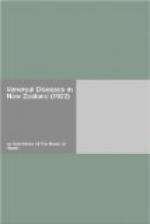As to gonorrhoea, these points may be noted: Auckland: A marked rise. Wellington: Steady rise with exception of females. Christchurch: Slight rise since 1920: females uniform rate. Dunedin: Slight rise, with indication of male increase in 1922.
Age Distribution.—The age-period of persons attending the clinics is mainly eighteen to thirty.
Marital Condition.—From the evidence of the clinics it is very apparent that venereal disease is especially a problem associated with the unmarried.
(C.) Mental Hospital Statistics.
A third source of estimation of prevalence was opened to the Committee by the Inspector-General of Mental Hospitals. The method of investigation adopted by Dr. Hay is based on Fournier’s estimate that 3 per cent. of the cases of syphilis existing at any one time will ultimately develop dementia paralytica.
The introduction of the Wassermann test and treatment by salvarsan or other arsenical preparations will vitiate this index in future, for the reasons that by the Wassermann test more cases will be diagnosed, and by the use of recent remedies the complete cure of many more cases will be effected, and consequently fewer will develop dementia paralytica. This disability does not develop until about ten to fifteen years after infection. The Wassermann test and the modern arsenical preparations have not yet been in use for that period, therefore these figures, as an estimate of the prevalence of syphilis in 1921, would not be materially affected by these developments. An estimate based on these data may therefore be regarded in the meantime as approximately correct.
During the past ten years 4,763 males and 3,747 females have been admitted into New Zealand mental hospitals. The percentage of syphilitic admissions of all types was 4.74, while the percentage of cases of dementia paralytica was 3.89. In other words, of the admission of syphilitics 82 out of every 100 cases were dementia paralytica. The average yearly number of deaths from dementia paralytica according to the Government Statistician’s returns between 1908 and 1921 was just under 40.
If Fournier’s estimate that 3 per cent. of syphilitics ultimately develop dementia paralytica be accepted, one would arrive at the annual infection by multiplying 40 by 33, which gives 1,320. Assuming the average duration of life, after infection, to be twenty-five years, this means that at any given time there are twenty-five years’ infections on hand. Dr. Hay computed from this the number of persons in New Zealand now who have, or have had, syphilis to be 1,320 x 25, equalling 33,000, or 1 to every 38 of the population. If the average duration of life after infection were assumed to be thirty years, the figures would be 1 to every 32 of the population.
Taking the figure for syphilitic infections over a period of years at 1,320 per annum, this would mean for the population of New Zealand (exclusive of Maoris) 1 fresh infection annually in about every 850 persons.




